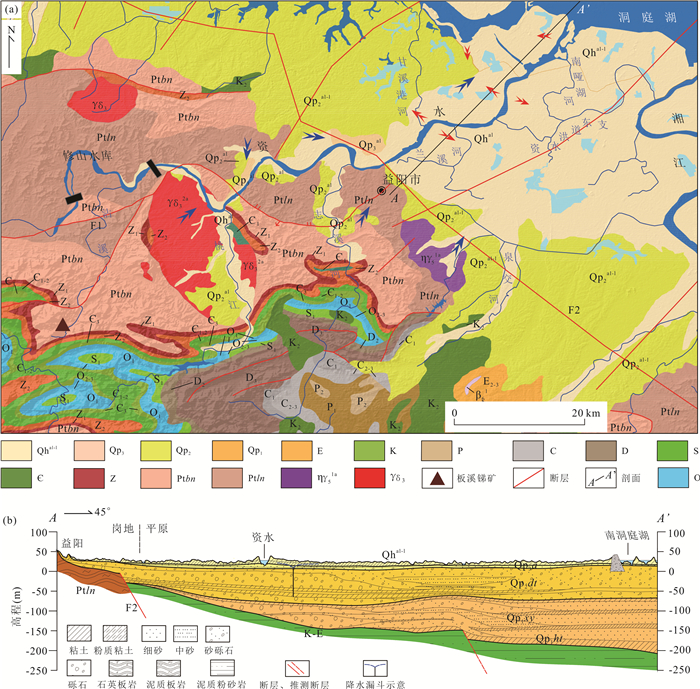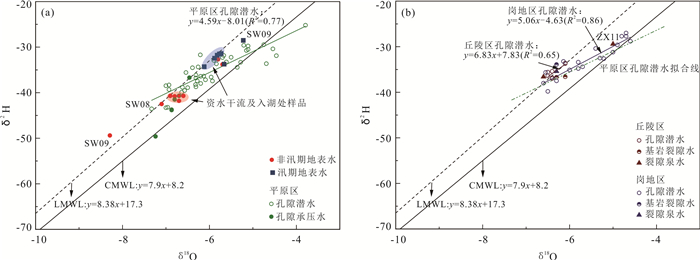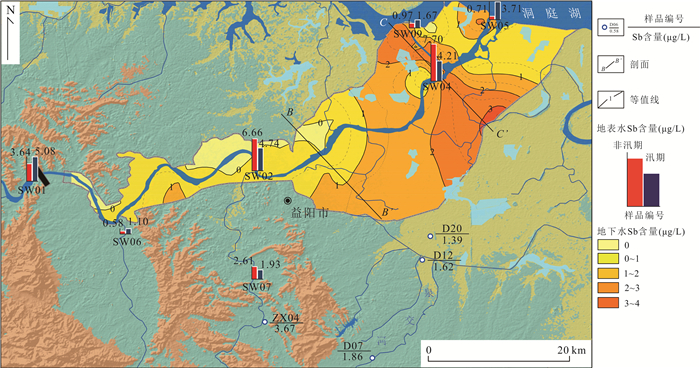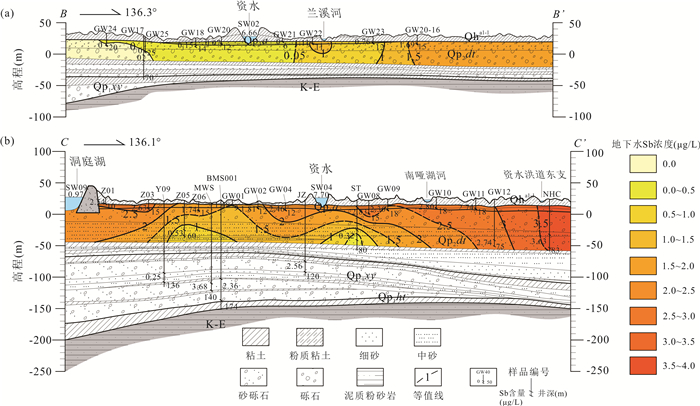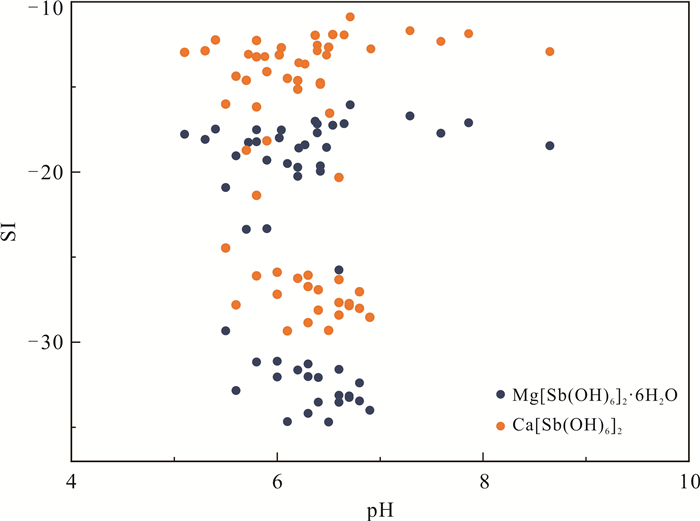Antimony Concentration and Distribution in Groundwater of Zi River Estuary and Source Analysis
-
摘要: 为查明资水尾闾第四系盆地地下水Sb含量特征,通过采集资水干流及尾闾地表水和不同类型地下水样品,运用水化学和$ {\rm{ \mathsf{ δ} }}^{2}\mathrm{H} $、$ {\rm{ \mathsf{ δ} }}^{18}\mathrm{O} $同位素与Sb含量的相关性分析,对地下水中Sb的含量及来源进行了研究.非汛期时,资水干流属于C类(> 5 μg/L),志溪河为B类(1~5 μg/L),其余地表水系为A类(< 1 μg/L),汛期时地表水系均属B类;A类孔隙潜水主要位于丘陵、岗地区资水两岸和部分平原滨湖地区,B类区域主要位于泉交河附近岗地区和大部分平原地区;部分孔隙承压水及受构造断裂影响的裂隙水为B类.含Sb矿物的溶解是孔隙承压水和裂隙水Sb的来源;地表水补给和灌溉水入渗导致潜水含水层Sb含量升高.Abstract: To find out the characteristics of Sb content in groundwater of Quaternary basin on the Zi River estuary area, in this paper it studies the distribution characteristics of Sb concentration and sources of Sb in groundwater by collecting surface water and groundwater samples from the main stream and estuary area, combined the correlation analysis of $ {\rm{ \mathsf{ δ} }}^{2}\mathrm{H},{\rm{ \mathsf{ δ} }}^{18}\mathrm{O} $ stable isotopes, hydrochemistry and Sb content. In non-flood season, the concentration of Sb in main streams of Zi River belongs to type C (> 5 μg/L), Zhixi River belongs to type B (1-5 μg/L), and other surface water samples belong to type A (< 1 μg/L). During flood period, all the surface water systems belong to type B. Type A areas of phreatic water were mainly distributed on part of plain area, lakeside area and Zi River bank which are at hills or hillock areas. Type B areas were those located at Quanjiao River and most of the plain area. Part of confined water was type A and the rest was type B. Fracture water which was affected by structural faults belongs to type B, otherwise was type A.The dissolution of Sb bearing minerals in the aquifer is the source of Sb in confined water and fracture water. The groundwater recharge from surface water and irrigation water resulted in Sb enrichment in phreatic water.
-
表 1 样品水化学分析结果描述性统计
Table 1. Descriptive statistical analysis of sample hydrochemistry data
pH Eh(mV) TDS (mg/L) K+ (mg/L) Na+ (mg/L) Ca2+ (mg/L) Mg2+ (mg/L) Cl‒ (mg/L) NO3‒ (mg/L) SO42‒ (mg/L) HCO3‒ (mg/L) 非汛期地表水(n=8) 最小值 6.90 126.00 158.02 1.86 3.17 19.07 2.20 3.08 1.99 6.00 85.40 最大值 8.67 201.00 245.02 3.59 8.30 67.06 8.82 7.38 8.26 23.08 128.90 平均值 7.86 165.00 194.23 2.52 5.44 34.71 5.91 4.89 4.09 14.18 108.86 C.V.(%) 7.19 13.90 15.38 27.02 31.26 43.66 40.36 32.38 52.22 42.51 13.27 汛期地表水(n=7) 最小值 6.78 64.60 119.67 1.93 3.75 22.61 3.00 5.40 4.29 12.68 54.90 最大值 7.44 146.90 178.34 3.74 5.63 35.85 5.31 6.29 10.34 20.36 99.13 平均值 7.18 104.59 152.76 2.47 4.53 29.71 4.17 5.90 7.64 16.73 81.59 C.V.(%) 3.63 30.35 15.42 23.98 15.93 16.20 19.87 5.25 31.25 13.77 22.69 孔隙潜水(n=71) 最小值 5.10 ‒181.00 59.38 0.18 0.96 3.20 0.91 0.00 0.00 0.00 10.68 最大值 8.65 251.00 864.04 6.75 34.77 137.88 40.52 55.65 250.07 167.93 318.73 平均值 6.30 79.80 229.68 1.80 10.70 31.60 8.65 10.94 10.86 14.39 121.46 C.V.(%) 9.03 174.75 57.86 73.95 69.22 82.57 83.33 84.19 306.68 170.80 59.27 孔隙承压水(n=5) 最小值 5.70 22.00 86.61 3.39 3.65 8.58 2.00 3.44 1.36 2.43 51.85 最大值 7.04 183.00 184.53 7.99 13.90 21.23 5.34 7.44 2.14 19.85 105.99 平均值 6.31 92.80 135.56 5.01 8.62 14.40 3.65 5.57 1.63 7.93 80.37 C.V.(%) 8.82 69.87 27.62 38.14 44.55 38.74 40.73 30.35 18.62 86.08 28.08 裂隙水(n=6) 最小值 5.88 79.00 50.70 0.36 1.22 3.04 1.60 1.86 0.79 0.92 18.30 最大值 7.86 195.00 710.15 3.73 11.08 80.44 17.47 18.22 10.62 71.83 410.36 平均值 6.75 153.33 193.11 1.54 4.59 20.27 4.69 6.36 5.69 14.66 98.01 C.V.(%) 11.96 29.22 131.62 104.11 84.39 146.34 133.66 98.83 76.75 191.81 156.71 表 2 样品Sb含量描述性统计
Table 2. Descriptive statistical analysis of Sb concentration
非汛期地表水(n=9) 汛期地表水(n=7) 孔隙潜水(n=71) 孔隙承压水(n=5) 裂隙水(n=3) 最小值 0.29 1.10 0.00 0.00 0.00 最大值 7.70 5.08 10.10 3.68 2.12 平均值 3.10 3.21 1.40 1.77 0.84 C.V.(%) 89.42 50.22 107.99 89.61 113.65 表 3 裂隙水水样点数据
Table 3. Data of fracture water samples
ID 类型 井深(m) 取水岩层 TDS(mg/L) 水化学类型 Sb含量(μg/L) GW30 裂隙泉水 \\ Ptln 50.70 HCO3-CaMg 0 GW36 裂隙泉水 \\ Ptln 93.07 HCO3-Ca 0 ZX11 裂隙泉水 \\ D3 710.15 HCO3-Ca 2.12 GW31 基岩裂隙水 120 Ptbn 111.91 HCO3-CaMg 1.34 GW40 基岩裂隙水 50 γδ3 102.51 HCO3-Ca 0 ZX01 基岩裂隙水 60 Ptbn 90.31 HCO3-CaMg 1.57 表 4 孔隙水Sb含量与水化学指标及微量元素的皮尔逊相关关系
Table 4. Pearson correlation coefficient of Sb concentration and hydrochemistry and trace elements in pore water
水岩作用来源(孔隙承压水) pH Eh TDS K+ Na+ Ca2+ Mg2+ Cl- Sb ‒0.10 ‒0.34 0.77* 0.49 0.52 0.58 0.56 0.80 NO3‒ SO42‒ HCO3‒ Fe Mn Zn Rb Sr Sb 0.48 0.76 0.70 ‒0.20 ‒0.38 0.87 0.67 0.64 随地表水‒地下水交互来源(孔隙潜水) pH Eh TDS K+ Na+ Ca2+ Mg2+ Cl‒ Sb ‒0.05 0.11 ‒0.13 ‒0.14 ‒0.05 ‒0.06 ‒0.09 ‒0.08 NO3‒ SO42‒ HCO3‒ Fe Mn Zn Rb Sr Sb 0.47** ‒0.15 ‒0.09 ‒0.10 0.02 ‒0.26 ‒0.17 ‒0.10 注:*在0.05级别(双尾),相关性显著;**在0.01级别(双尾),相关性显著. -
Asaoka, S., Takahashi, Y., Araki, Y., et al., 2012. Comparison of Antimony and Arsenic Behavior in an Ichinokawa River Water–Sediment System. Chemical Geology, 334(12): 1-8. Casiot, C., Ujevic, M., Munoz, M., et al., 2006. Antimony and Arsenic Mobility in a Creek Draining an Antimony Mine Abandoned 85 Years Ago (Upper Orb Basin, France). Applied Geochemistry, 22(4): 788-798. Chen, Y. W., Deng, T. L., Filella, M., et al., 2003. Distribution and Early Diagenesis of Antimony Species in Sediments and Porewaters of Freshwater Lakes. Environmental Science & Technology, 37(6): 1163-1168. https://doi.org/10.1021/es025931k Ding, J. H., Zhang, Y. B., Ma, Y., et al., 2021. Metallogenic Characteristics and Resource Potential of Antimony in China. Journal of Geochemical Exploration, 230: 106834. doi: 10.1016/j.gexplo.2021.106834 Filella, M., Belzile, N., Chen, Y. W., 2002. Antimony in the Environment: A Review Focused on Natural Waters: Ⅰ. Occurrence. Earth-Science Reviews, 57(1): 125-176. Fu, S. Y., Shen, C. M., 2020. Geological Characteristics of Banxi Antimony Deposit in Taojiang County of Hunan Province. Geological Survey of China, 7(1): 30-37 (in Chinese with English abstract). General Geological Environment Monitoring Station of Hunan Province, 1996. Regional Hydrogeological Survey Report of Ziyang District, Yiyang City, Hunan Province. General Geological Environment Monitoring Station of Hunan Province, Changsha (in Chinese). Guo, X. J., Wang, K. P., He, M. C., et al., 2014. Antimony Smelting Process Generating Solid Wastes and Dust: Characterization and Leaching Behaviors. Journal of Environmental Sciences, 26(7): 1549-1556. doi: 10.1016/j.jes.2014.05.022 Han, J., Xu, J., Yi, L., et al., 2022. Seasonal Interaction of River Water-Groundwater-Salt Lake Brine and Its Influence On Water-Salt Balance in the Nalenggele River Catchment in Qaidam Basin, NW China. Journal of Earth Science, 33(5): 1298-1308. doi: 10.1007/s12583-022-1731-0 Hao, C. M., Zhang, W., Gui, H. R., 2020. Hydrogeochemistry Characteristic Contrasts between Low- and High-Antimony in Shallow Drinkable Groundwater at the Largest Antimony Mine in Hunan Province, China. Applied Geochemistry, 117: 104584. doi: 10.1016/j.apgeochem.2020.104584 He, M. C., Wang, X. Q., Wu, F. C., et al., 2012. Antimony Pollution in China. The Science of the Total Environment, 421/422: 41-50. https://doi.org/10.1016/j.scitotenv.2011.06.009 Herath, I., Vithanage, M., Bundschuh, J., 2017. Antimony as a Global Dilemma: Geochemistry, Mobility, Fate and Transport. Environmental Pollution, 223: 545-559. https://doi.org/10.1016/j.envpol.2017.01.057 Hu, X. W., 1995. The Geological Setting and Genesis of Xikuangshan Super-Giant Antimony Deposits, Hunan Province, China (Dissertation). Graduate School of Chinese Academy of Geological Sciences, Beijing (in Chinese with English abstract). Ji, R. S., 1986. The Structure Characteristics and the Mechanism of Ore-Control of Xikuangshan Antimony Field, Hunan Province. Earth Science, 11(5): 525-532 (in Chinese with English abstract). Johnson, C. A., Moench, H., Wersin, P., et al., 2005. Solubility of Antimony and Other Elements in Samples Taken from Shooting Ranges. Journal of Environmental Quality, 34(1): 248-254. doi: 10.2134/jeq2005.0248 Johnston, S. G., Bennett, W. W., Doriean, N., et al., 2020. Antimony and Arsenic Speciation, Redox-Cycling and Contrasting Mobility in a Mining-Impacted River System. Science of the Total Environment, 710: 136354. doi: 10.1016/j.scitotenv.2019.136354 Joyanto, R., Mohammed, I., 1996. Trace-Element Geochemistry of Onion Creek near Van Stone Lead-Zinc Mine (Washington, USA) : Chemical Analysis and Geochemical Modeling. Chemical Geology, 133(1-4): 211-224. doi: 10.1016/S0009-2541(96)00091-5 Kang, M., Kawasaki, M., Tamada, S., et al., 2000. Effect of pH on the Removal of Arsenic and Antimony Using Reverse Osmosis Membranes. Desalination, 131(1-3): 293-298. doi: 10.1016/S0011-9164(00)90027-4 Li, D., Deng, Y. M., Du, Y., et al., 2021. Isotopic Indication of Spatial Heterogeneity of Arsenic in Shallow Groundwater of Middle Yangtze River Lacustrine Plain. Earth Science, 46(12): 4492-4502 (in Chinese with English abstract). Lian, S. T., 2011. Enviroment Quality Assessment of Shallow Groundwater in the Area of Dongting Lake (Dissertation). Hunan University of Science and Technology, Xiangtan (in Chinese with English abstract). Liang, X., Zhang, R. Q., Pi, J. G., et al., 2001. Characteristics of Tectonic Movement Dongting Basin in the Quaternary Period. Geological Science and Technology Information, 20(2): 11-14 (in Chinese with English abstract). Lin, Z. W., Wu, Q. H., Li, H., et al., 2020. The Genesis of Two Types of Quartz Veins in Banxi Antimony Deposit and Their Prospecting Significance. Earth Science, 45(5): 1503-1516 (in Chinese with English abstract). Liu, R. P., Xu, W., He, Z., et al., 2015. Adsorption of Antimony (Ⅴ) onto Mn(Ⅱ)-Enriched Surfaces of Manganese-Oxide and FeMn Binary Oxide. Chemosphere, 138: 616-624. doi: 10.1016/j.chemosphere.2015.07.039 Liu, W. H., Ma, T., Li, J. Q., et al., 2021. Polltion Assessment and Souce Analysis of Heavy Metals in Agricultural Soil around Zijiang River Estuary. Bulletin of Geological Science and Technology, 40(2): 138-146 (in Chinese with English abstract). Majzlan, J., Števko, M., Lánczos, T., 2016. Soluble Secondary Minerals of Antimony in Pezinok and Kremnica (Slovakia) and the Question of Mobility or Immobility of Antimony in Mine Waters. Environmental Chemistry, 13(6): 927-935. doi: 10.1071/EN16013 Milham, L., Craw, D., 2009. Antimony Mobilization through Two Contrasting Gold Ore Processing Systems, New Zealand. Mine Water and the Environment, 28(2): 136-145. doi: 10.1007/s10230-009-0071-y Mitsunobu, S., Harada, T., Takahashi, Y., 2006. Comparison of Antimony Behavior with That of Arsenic under Various Soil Redox Conditions. Environmental Science & Technology, 40(23): 7270-7276. Multani, R. S., Feldmann, T., Demopoulos, G. P., 2016. Antimony in the Metallurgical Industry: A Review of Its Chemistry and Environmental Stabilization Options. Hydrometallurgy, 164: 141-153. doi: 10.1016/j.hydromet.2016.06.014 Niyazi, A., Celalettin, S., Orhan, G., 2009. Groundwater Contamination Mechanism in a Geothermal Field: A Case Study of Balcova, Turkey. Journal of Contaminant Hydrology, 103(1-2): 13-28. doi: 10.1016/j.jconhyd.2008.08.006 Pierart, A., Shahid, M., Séjalon-Delmas, N., et al., 2015. Antimony Bioavailability: Knowledge and Research Perspectives for Sustainable Agricultures. Journal of Hazardous Materials, 289: 219-234. https://doi.org/10.1016/j.jhazmat.2015.02.011 Rao, J. R., Wang, J. H., Cao, Y. Z., 1993. Deep Structure in Hunan. Hunan Geology, (S1): 2-3 (in Chinese with English abstract). Regional Geologic Survey Team of Hunan Geology Bureau, 1974. Regional 1/200 000 Hydrogeological Survey Report of Changsha H-49-35. Regional Geologic Survey Team of Hunan Geology Bureau, Changsha (in Chinese). Sun, L. Q., Zhang, X., Liang, X., et al., 2021. Identification and Characteristics of the Sedimentary Environment since the Quaternary in Zi River Delta, Dongting Basin. Earth Science, 46(9): 3245-3257 (in Chinese with English abstract). Wang, X. Q., He, M. C., Xi, J. H., et al., 2010. Antimony Distribution and Mobility in Rivers around the World's Largest Antimony Mine of Xikuangshan, Hunan Province, China. Microchemical Journal, 97(1): 4-11. Wen, B., 2017. Implications of Isotope for Sources, Migration and Transformation of Antimony in the Water Environment of the Xikuangshan, Hunan(Dissertation). China University of Geosciences, Wuhan (in Chinese with English abstract). Wen, B., Zhou, A. G., Zhou, J. W., et al., 2018. Coupled S and Sr Isotope Evidence for Elevated Arsenic Concentrations in Groundwater from the World's Largest Antimony Mine, Central China. Journal of Hydrology, 557: 211-221. doi: 10.1016/j.jhydrol.2017.12.013 Wilson, S. C., Lockwood, P. V., Ashley, P. M., et al., 2010. The Chemistry and Behavior of Antimony in the Soil Environment with Comparisons to Arsenic: A Critical Review. Environmental Pollution, 158(5): 1169-1181. doi: 10.1016/j.envpol.2009.10.045 Wu, H. W., Zhang, X. P., Sun, G. L., et al., 2012. Variations of Stable Isotopic Characteristics of Atmospheric Precipitation from Changsha, Hunan. Resources and Environment in the Yangtze Basin, 21(5): 540-546 (in Chinese with English abstract). Xie, L. N., Nyirenda, M. T., Zhou, J. W., et al., 2016. Mine Waste Acidic Potential and Distribution of Antimony and Arsenic in Waters of the Xikuangshan Mine, China. Applied Geochemistry, 77: 52-61. Xie, L. N., Zhou, J. W., Hao, C. M., et al., 2016. Hydrochemical Characteristics and Contaminative Causes of Groundwater in the North Area of Xikuangshan Antimony Mine, Hunan Province. Geological Science and Technology Information, 35(2): 197-202 (in Chinese with English abstract). Yang, H., 2017. Migration Mechanism and Environmental Effects of Heavy Metals around an Antimony Mine Area in Central China (Dissertation). Hunan University, Changsha (in Chinese with English abstract). Zhang, R. Q., Liang, X., Duan, W. Z., et al., 2003. Systematic Analysis of Dongting Lake Evolution, Flood Disaster Creation and Development. China University of Geosciences Press, Wuhan (in Chinese). Zhang, Z. X., Lu, Y., Li, H. P., et al., 2018. Assessment of Heavy Metal Contamination, Distribution and Source Identification in the Sediments from the Zijiang River, China. Science of the Total Environment, 645(15): 235-243. Zhao, J. X., Li, C. A., Zhang, Y. F., et al., 2016. Quaternary Chronostratigraphy of Borehole S3-7 in Dongting Basin. Earth Science, 41(4): 633-643 (in Chinese with English abstract). Zheng, S. H., Hou, F. G., Ni, B. L., 1983. Hydrogen and Oxygen Isotopic Studies of Meteoric Water in China. Chinese Science Bulletin, 28(13): 801-806 (in Chinese). doi: 10.1360/csb1983-28-13-801 Zou, S., Zhang, D., Li, X. Q., et al., 2022. Sources and Pollution Pathways of Deep Groundwater Sulfate Underneath the Piedmont Plain in the North Henan Province. Earth Science, 47(2): 700-716 (in Chinese with English abstract). 付胜云, 沈长明, 2020. 湖南省桃江县板溪锑矿床地质特征研究. 中国地质调查, 7(1): 30-37. https://www.cnki.com.cn/Article/CJFDTOTAL-DZDC202001005.htm 胡雄伟, 1995. 湖南锡矿山超大型锑矿床成矿地质背景及矿床成因(博士学位论文). 北京: 中国地质科学院. 湖南省地质环境检测总站, 1996. 湖南省益阳市资阳区赫山区区域水文地质调查报告. 长沙: 湖南省地质环境检测总站. 吉让寿, 1986. 湖南锡矿山锑矿田成矿期构造特征及控矿机制. 地球科学, 11(5): 525-532. https://www.cnki.com.cn/Article/CJFDTOTAL-DQKX198605010.htm 李典, 邓娅敏, 杜尧, 等, 2021. 长江中游河湖平原浅层地下水中砷空间异质性的同位素指示. 地球科学, 46(12): 4492-4502. doi: 10.3799/dqkx.2021.054 连生土, 2011. 洞庭湖区浅层地下水环境质量评价研究(硕士学位论文). 湘潭: 湖南科技大学. 梁杏, 张人权, 皮建高, 等, 2001. 洞庭盆地第四纪构造活动特征. 地质科技情报, 20(2): 11-14. https://www.cnki.com.cn/Article/CJFDTOTAL-DZKQ200102002.htm 林智炜, 吴堑虹, 李欢, 等, 2020. 板溪锑矿两类石英脉成因及其对找矿的指示意义. 地球科学, 45(5): 1503-1516. doi: 10.3799/dqkx.2019.207 刘文辉, 马腾, 李俊琦, 等, 2021. 资江河口区农田土壤重金属污染评价及来源分析. 地质科技通报, 40(2): 138-146. https://www.cnki.com.cn/Article/CJFDTOTAL-DZKQ202102017.htm 饶家荣, 王纪恒, 曹一中, 1993. 湖南深部构造. 湖南地质, (S1): 2-3. https://www.cnki.com.cn/Article/CJFDTOTAL-HNDZ901.004.htm 湖南省地质局区测队, 1974. 长沙幅H-49-35 1/20万区域水文地质调查报告. 长沙: 湖南省地质局区测队. 孙立群, 张鑫, 梁杏, 等, 2021. 洞庭盆地资水三角洲地区第四纪沉积环境判别及其特征. 地球科学, 46(9): 3245-3257. doi: 10.3799/dqkx.2020.357 温冰, 2017. 湖南锡矿山水环境中锑来源及迁移转化的多元同位素解析(博士学位论文). 武汉: 中国地质大学. 吴华武, 章新平, 孙广禄, 等, 2012. 湖南长沙地区大气降水中稳定同位素特征变化. 长江流域资源与环境, 21(5): 540-546. https://www.cnki.com.cn/Article/CJFDTOTAL-CJLY201205005.htm 谢李娜, 周建伟, 郝春明, 等, 2016. 湘中锡矿山北矿区地下水化学特征及污染成因. 地质科技情报, 35(2): 197-202. https://www.cnki.com.cn/Article/CJFDTOTAL-DZKQ201602038.htm 杨宏, 2017. 锡矿山重金属污染物迁移机制及其环境效应(硕士学位论文). 长沙: 湖南大学. 张人权, 梁杏, 段文忠, 等, 2003. 洞庭湖区演变及洪灾成生与发展的系统分析. 武汉: 中国地质大学出版社. 赵举兴, 李长安, 张玉芬, 等, 2016. 洞庭盆地S3-7孔第四纪年代地层. 地球科学, 41(4): 633-643. doi: 10.3799/dqkx.2016.052 郑淑蕙, 侯发高, 倪葆龄, 1983. 我国大气降水的氢氧稳定同位素研究. 科学通报, 28(13): 801-806. https://www.cnki.com.cn/Article/CJFDTOTAL-KXTB198313010.htm 邹霜, 张东, 李小倩, 等, 2022. 豫北山前平原深层地下水硫酸盐来源与污染途径的同位素示踪. 地球科学, 47(2): 700-716. doi: 10.3799/dqkx.2021.043 -










 下载:
下载:
